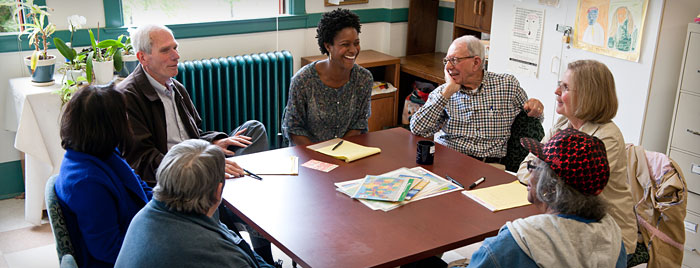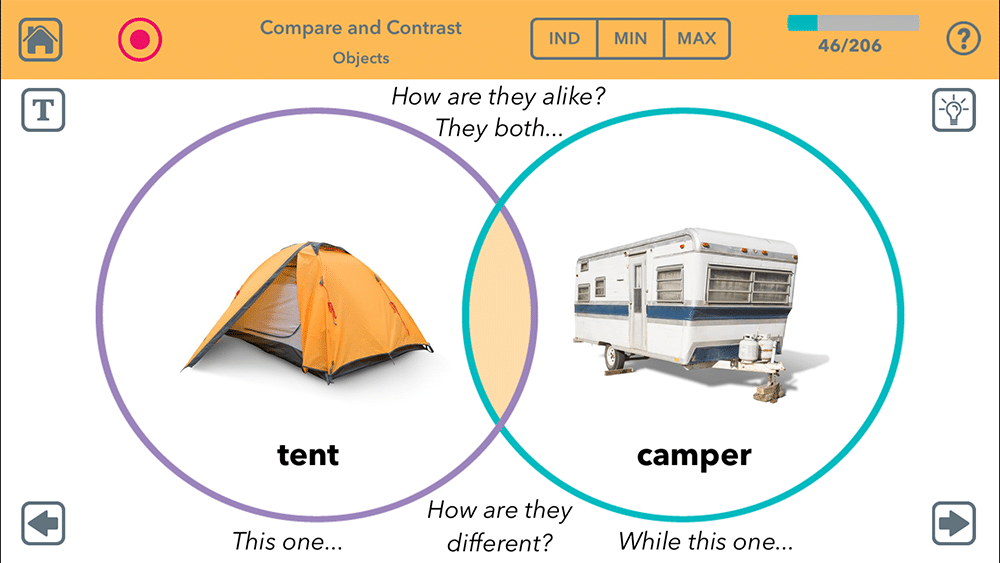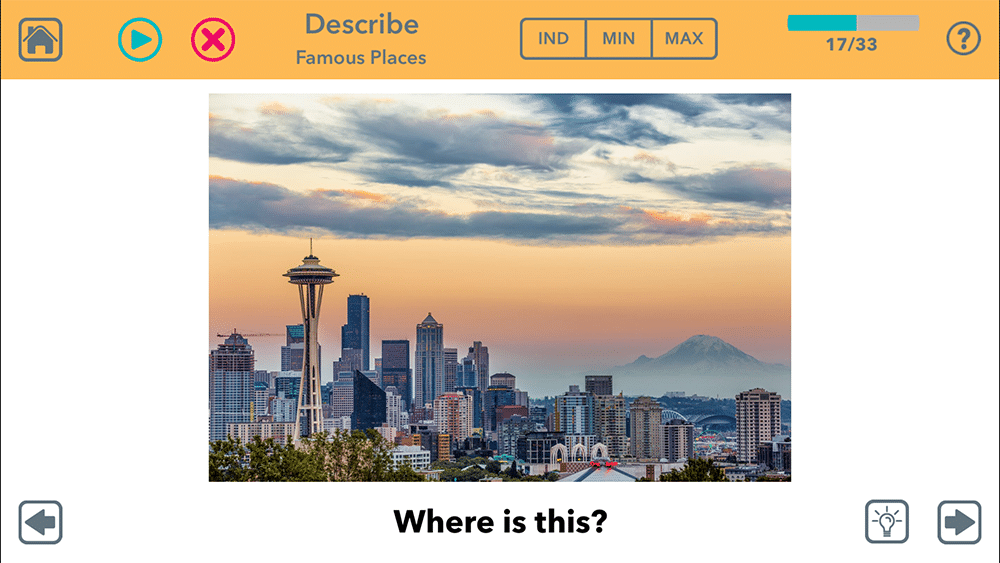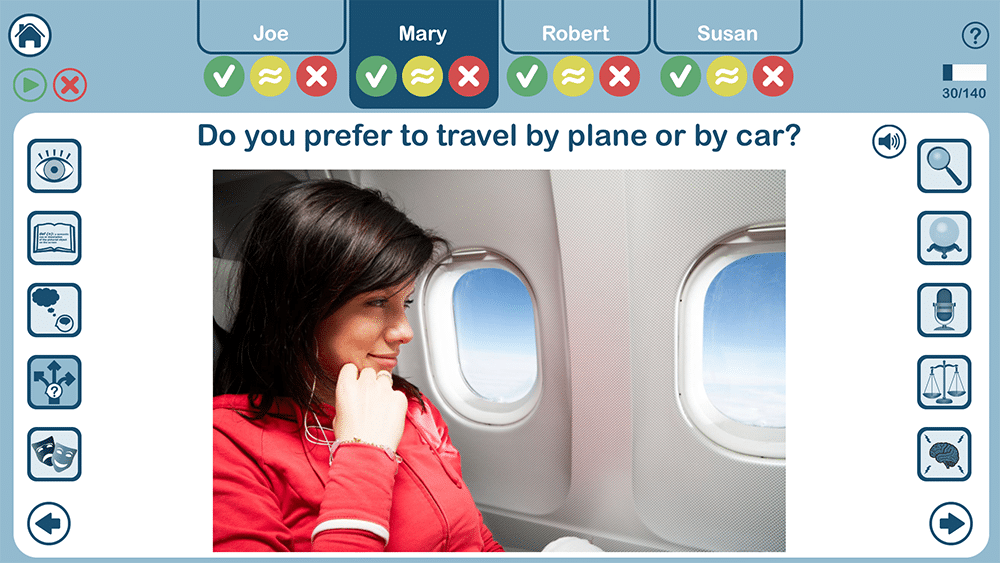Building Confidence in Communication: Using Apps in Aphasia Group Therapy
6 min read
Aphasia can create barriers to communication that significantly affect a person’s wellbeing. With reduced confidence in communication abilities, social participation often declines — resulting in diminished participation in everyday life activities.1 Even after successfully achieving goals to improve language functions in speech therapy, a person may struggle to use their new communication skills with people other than their therapist or close family and friends. So, what can we do to bridge the gap between therapy and those all-important conversations in the real world?
Bridging the gap with aphasia group therapy
Aphasia group therapy is a recognized way of developing the communication skills and psychological wellbeing of people with aphasia.2 Not only do groups provide a supportive environment for people to practice the skills they have developed in individual therapy, aphasia group therapy also provides opportunities for increased social participation with a variety of conversation partners.

Group participants benefit from watching others in the group model ‘total communication’ strategies. They can develop relationships with other aphasia group members in a natural environment, whilst having meaningful conversations with people who can empathize first hand with their difficulties. Peers can be tough judges, but also offer highly encouraging praise — and their feedback is often more valuable than that of the speech-language pathologist3.
With changes in healthcare funding, groups are becoming a larger part of how speech therapy is delivered. Read group therapy ideas from The Traveling Traveler about more than just aphasia.
Do all participants in aphasia group therapy have to have a similar communication goal?
The overall aim of aphasia group therapy is to improve participants’ wellbeing by encouraging social interaction and enhancing life participation outside of therapy room (you can read more about how to set specific goals for your therapy here). How you achieve this depends on the group members, their specific needs, and the activities you use within your group.
It’s fine to have each member of your group working on different goals depending on their differing communication styles and levels of impairment. For example, Mr. X may be working on using gesture to communicate his messages, whilst Mr. Y is trying hard to generalize his use of semantic feature analysis. As long as each of the group members is supported equally in communicating a message that can be understood by their peers, a successful interaction can take place.
Planning sessions for aphasia group therapy
Each session of your aphasia group may focus on a different topic area, but it’s useful to use the same format for each session so that participants become used to the routine. A treatment plan for aphasia group therapy may look something like this:
Opening
As participants arrive, a brief period of unstructured social time allows everyone to settle in and relax prior to the structured activities.
Introduction
The therapist leads this section of the group, introducing the topic of the day and the language skills that will be targeted within the session. Examples of topics and language skills may include:
Topics
- Travel
- Hobbies
- Health matters
- Film/TV
- Music
- Sports
- Current affairs
- Famous people
Language Skills
- Describing
- Saying numbers
- Using longer sentences
- Asking questions
- Giving answers
- Staying on topic
- Understanding
- Word retrieval strategies
Looking for more topics and goals? The Stroke Comeback Center has a fantastic book called Groups that Work that you can use for your aphasia group therapy sessions!
Language Skills
Participants are given the opportunity to practice specific language skills within focused tasks.
Generalization
Participants enter into group conversations using the strategies and language skills they have practiced during the session.
It’s a good idea to have some communication ramps readily available to support participants’ expressive and receptive communication. Ramps may include pictures, photos, maps or calendars as well as tools such as paper and pens. If participants have their own communication books or ramps, encourage them to bring them along too! It is often effective to ask participants to bring in items related to the group topic to promote discussion (e.g. souvenirs from their vacations, their favorite CD, an item relating to their hobby).
Can I use apps in aphasia group therapy?
Now you’re talking! Apps can be a great resource both in one-to-one aphasia therapy and in aphasia group therapy. As when planning any therapy, decide which topics and language skills you want to work on within your session, then choose the appropriate apps to help you work towards your aims. Let’s look at an example:
Say I want to run a group that encourages conversation about vacations. I might want to focus on the language skills of word retrieval, questions, and describing. So, which apps could I use?
Advanced Naming Therapy
Compare activity: Use this app to encourage conversations about the similarities and differences between two objects or concepts. This exercise targets semantics, word finding and verbal organization – all equally important skills for a successful conversation. Encourage the participants to use their new compare and contrast skills later in the group when discussing their own travel experiences. What aspects of their trips were the same or different when compared with their peers?
What’s the best way to camp? Discuss the pros and cons of tent vs camper while organizing ideas into clear language.
Describe activities: The unusual and funny pictures are sure to promote discussion within the group and hopefully raise a smile – an important form of non-verbal communication! Choose the ‘Famous Places’ category and describe the pictures together. Chat about whether anyone in the group has been to these places. Can that person describe their time there? What questions can the group think of to ask them?
Can members recognize Seattle, Washington? Who has been there?
Advanced Naming Therapy
Express yourself better with challenging word-finding exercises for aphasia and cognitive-communication problems.
Conversation Therapy
This is a great app to use for generalized conversation in any aphasia group therapy session. The question types promote thought-provoking conversation and encourage animated discussion between group participants. The option of ‘group play’ also allows for simple and accurate recording of participants’ use of strategies for achieving targets, making life easy for the therapist when it comes to note writing.
Have a conversation about each picture, using the 10 questions to get you started. Use strategies to share opinions & experiences.
Conversation Therapy
Engage in real-life discussions with pictures & questions that get people talking to practice communication strategies.
Having had the opportunity to practice their communication skills using the apps, participants should be feeling more confident about entering into discussion with each other about the chosen aphasia group therapy topic. So, let the participants take the lead! Facilitate when necessary and enjoy seeing where the conversation takes you.
What do I need to consider when using apps for aphasia group therapy?
Probably the most important thing you need to consider is how you’re going to make sure everyone can see the iPad! Using one iPad and passing it around the group is an option, however this can often seem boring for the participants who are waiting their turn as they cannot see or join in with the current task. This also limits the learning participants can benefit from when watching others.
So how do we get around this issue? Can we mirror the iPad screen onto a TV or presentation screen so that the whole group can see it at once? We sure can! Macworld provide some useful advice on how to do exactly that in this article.
Skills for Life
Conversation is one of the most important functions of communication. Not only do we use conversation to talk about the weather, the nightmare traffic on the way into work, or what we watched on television last night, it is through conversation that we portray our own identity. So, have fun with aphasia group therapy! Promote the importance of social interactions, assist participants in building lasting relationships with other group members, and help people with aphasia develop the skills to participate in the rest of their lives.
References
- Ross, A., Winslow, I., Marchant, P., & Brumfitt, S. (2006). Evaluation of communication, life participation and psychological wellbeing in chronic aphasia: the influence of group intervention. Aphasiology, 20(5), 427-448.
- Elman, R., & Bernstein-Ellis, E. (1999). The efficacy of group communication treatment in adults with chronic aphasia. Journal of Speech, Language, & Hearing Research, 42(2), 411-9.
- Richman, M., Redmond, S., & Williamson, D. The ABC’s of group treatment for aphasia.www.asha.org/events/convention/handouts/2009/2363_redmond_suzanne_coyle/



